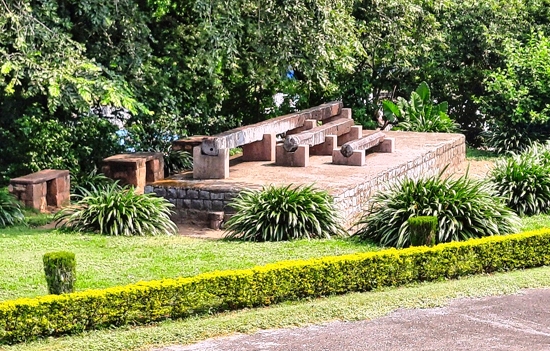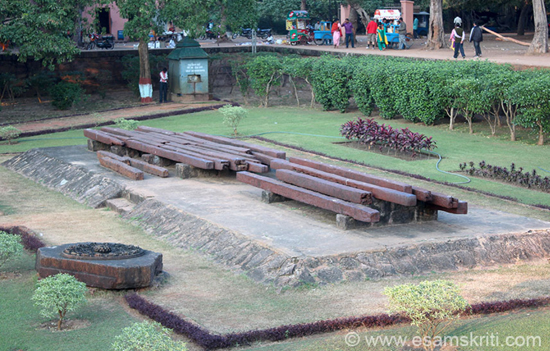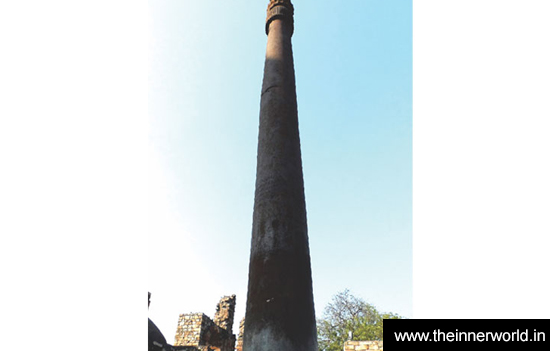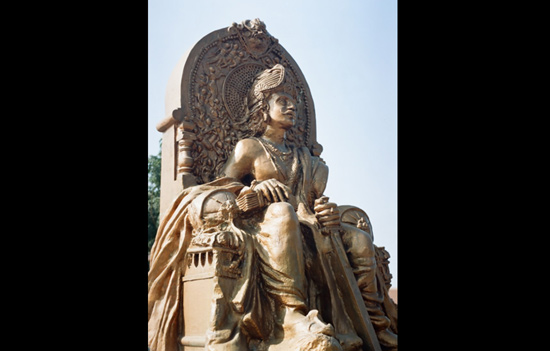- Briefly know about the Iron Pillars of
India and history/technical matters of the Iron Pillar of Dhar. This pillar was
broken during foreign rule and is hardly spoken about unlike the one in Delhi.
The Iron Pillar in the Qutub Complex,
Delhi if often spoken about. But it is only recently that I got to know about the
Iron Pillar in Dhar, Madhya Pradesh. It is attributed to Raja Bhoj. Iron Pillars found in many parts of India. Read
on.
Compiled by Sanjeev
1. Iron Pillar in the Qutub Complex, Delhi.

Er. Mayadhar Swain, Editor, Science Horizon wrote in Odisha Review published by the Government of Odisha, “The height of the pillar, from the top to the bottom of its base, is 7.67 m, 1.12 m of which is below ground. It weighs more than 6 tons. According to a six-line Sanskrit inscription in Brahmi script on the surface of the pillar, it was erected by “Chandra as a standard of Vishnu at Vishnupadagiri”. Vishnupadagiri has been identified with modern day Udayagiri near Sanchi in Madhya Pradesh and Chandra with the Gupta Emperor Chandragupta II Vikramaditya (r.375 – 414 CE). The pillar was brought to its current location in New Delhi’s Qutb Complex in 1233.” 3
2.
Iron Pillar in Bhojashala, Dhar. Pillar broke when Mughals tried to shift it.
 Pillar was broken into pieces.
Pillar was broken into pieces.
 Close-up of Dhar pillar.
Close-up of Dhar pillar.
“The Iron Pillar of Dhar, originally almost twice as tall as its counterpart in Delhi, is preserved in the compound of the Lat Masjid (‘lat’ means ‘pillar’). The Dhar pillar is in three pieces, placed horizontally on a platform in the mosque compound. When standing vertically, the pillar would have soared 14 meters high.” 2 Height 42 feet. Note Dhar was the capital of Raja Bhoj.
“Astonishingly, the Pillar, just like the one in Delhi, is rust-resistant, which means the craftsmen had used advanced metallurgical techniques.” 3 The pillar, at full height,
was the highest pillar of its kind in the world.
3. Iron pillar at Kodachadri in coastal Karnataka, close to Udupi.

“The 8.7-metre-tall Kodachadri iron pillar popularly known as the Dwajasthamba (flag staff) and weighing 500 kg, is located at the Adi Mookambika temple at Kodachadri in Karnataka.” 3
“Undoubtedly, ancient Indians were masters in iron metallurgy. The same technology as was used for the iron pillars was also used to manufacture huge iron beams, such as at Puri Jagannath temple (12th century).” 3
4.
Iron beams that were used inside Sun Temple, Konarak, Orissa on display.

“The iron beams at Konark’s famous Sun temple are even larger dimensions. Chemical analysis done in one of the beams shows that it is wrought iron mixed with phosphorus (99.64% iron, 0.15% phosphorus, traces of carbon and sulfur and no manganese).” 3 “The number of beams in one of the Puri Temples (the Garden Temple) alone has been counted as 239. In the Konarak Temple the beams, though smaller in number, reach even a larger size namely 35’ in length and 7” or 7.5” square in section.” 2 Pg 519
5. Iron Pillar at Achaleshwara Temple near Mount Abu. Height 12 feet 9 inches.

I share extracts-gist from ‘A new study on the Dhar Iron Pillar’ by Dr Prof R Balasubramaniam, Prof of Metallurgy at IIT Kanpur, published in Indian Journal of history of Science. The paper covers structural features, manufacturing technology and a metallurgical analysis. Downloaded from
IIT Kanpur website. To download PDF click on PDF All credits to author.
Brief History
Dhar was founded by Raja Bhoja
(1010-1053). Around 1300 A.D. it fell into Muslim hands for the first time. Alauddin
Khilji was the first foreign invader of interior Malwa. Hoshang Shah
(1400-1435) became the first Muslim ruler of Malwa. Bhoj was well versed in
iron metallurgy as he wrote in his Yuktikalpataru,
discussed the manufacture of iron weapons. Indic scholar Subhash Kak
wrote that Bhoj wrote 84 books one of which was, “Rāja-mṛgāṅka-karaṇa,
a treatise on chemistry, especially dealing with the extraction of metals from
ores, and production of various drugs.
Since Bhoj was a Shiva worshipper
it is possible the iron pillar had a trishul
(trident) on top and was placed opposite the Siva temple in Dhar. The probable
name of the temple was Latesvara
because the name of the location of this region was Latesvara Mandala. Is that how Lat (pillar) Masjid gets its name?
The masjid was erected out of remains of Hindu and Jain temples in 1405.
A fourth part of the broken pillar was probably installed at Dilawar Khan’s mosque in Mandu.
Bahadur Shah of Gujarat, during Jehangir’s reign, wanted to shift the pillar to Gujarat around 1531. It broke into pieces when he tried. The combined weight of the Dhar pillar is atleast a ton more than the Delhi one.
Technical matter
Do see Fig 10 in PDF which attempts
to reconstruct the iron pillar (pg 16).
The lower portion of the Dhar
pillar was not buried underground unlike the Delhi pillar. The iron pillar has
been forge welded by horizontal forge welding technique. The Dhar pillar in its
completed state would be the largest forge welded iron pillar in the world.
To know about Corrosion
Resistance refer pg 27 of PDF. Cousens commented that local people believe the
pillar was made of astadhatu, an
alloy of five or eight metals.
For Conclusions refer pg 32 of
PDF. The microstructure of Dhar Pillar iron is characteristic of ancient Indian
iron. The corrosion behaviour of Dhar Pillar iron has been compared with 0.5%
mild steel and another Gupta period (6th century a.d.) iron.
End of matter from Prof R Balasubramaniam study.
 Vikramaditya at Vikramaditya University, Ujjain.
Vikramaditya at Vikramaditya University, Ujjain.
Since the Guptas are referred to above some information about Gupta Kings. 2
1. About 320 A.D., Chandra-gupta I, the founder of
the Gupta Empire, revived the chakravarti ideal in North India.
2. Placed between 335-350 A.D. Samundragupta laid
the foundation of a military machine.
3. Next was Chandragupta II (376-414), known as Vikramaditya, acclaimed
as the greatest of the Gupta emperors. .
4. Then was son Kumara-gupta (415-55 a.d.) and grandson, Skanda-gupta
(455 to 467 a.d.) who inflicted a defeat on the invading Hunas
Although the Guptas were devoted
to Vishnu, the worship of Siva was more popular. Vikramaditya introduced copper
and silver unlike his predecessors who had only gold coins. Reverse of the coin
had Garuda, vehicle of Lord Vishnu
eSamskriti is grateful to the authors who wrote about Iron Pillars esp. the forgotten Iron Pillar of Dhar.
Note that Adhai din ka jhopda
mosque in Ajmer was a Sanskrit
college and is made from ruins of Hindu/Jain temples in the 12th
century. To
see album
References
1. Article on Iron
Pillar at Kodachadri by Harita
2.
Volume 3 and 5 of The History and Culture
of Indian People published by the Bharatiya Vidya Bhavan
3. Iron
Pillars of India
Also
read
1. Raja Bhoj the
great scholar king
2. About
the Gupta Empire
3. How Temples
destroyed by invaders can be claimed back by Sanatanis